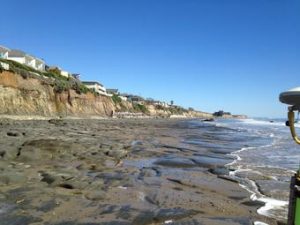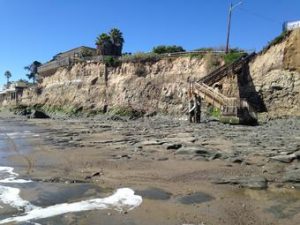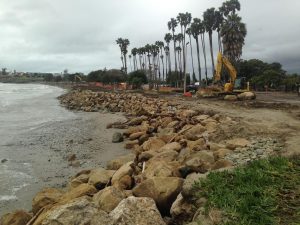Rising Sea Levels Threaten SoCal Beaches
Scientists announced earlier this year that Southern California could be left with few usable beaches by the end of the century because of rising seas that are gradually eating away coastal sand and bedrock.
SoCal beaches an important part of California’s more than $40-billion annual coastal economy.
But, without mountains of sand and beach nourishment, Southern California beaches may disappear by the year 2100 as sea levels rise.
And this has many South Bay residents frustrated.
“That would be really upsetting,” says frequent Manhattan beach-goer Emma Madison. “I love going to the beach, and not having that there would be a sad thing for a lot of people.”

Exposed bedrock on the beach during low tide at Isla Vista, California | Alex Snyder, U.S. Geological Survey
“This definitely impacts me,” says Redondo Beach resident Joey Jennings. “I try to go surfing as much as I can. The fact that sea levels are rising could totally ruin the territory. I definitely want to take a step in preserving our beaches.”
This is bad news for surfers, too. Although wave conditions influence beach erosion in the short term, sea-level rise becomes the dominant eroding force in the long term.
“We want the sand, obviously,” says Manhattan beach resident Chad Kroeger. “Being a surfer, you want to surf and then go chill on the beach. We’ve got to stop erosion because we want to bronze. I don’t want to bronze on rocks.”
Beach erosion and rising sea levels are also a huge problem economically, because beaches support shoreline life and attract tourists. But now, beaches and their communities are evolving dramatically.
This distressful finding comes from a research project by the United States Geological Survey (USGS). The team examined 500 kilometers of SoCal’s coast, extending from the Mexican border to Point Conception. This coastal region is home to 18 million residents as well as extensive infrastructure.

Isla Vista, California | Alex Snyder, U.S. Geological Survey
“SoCal was chosen because it may be the region in California with the most to lose if sea level rises one meter above present,” says Sean Vitousek, lead author of the USGS study. “We conducted this study by combining several of the best data sets available and running numerous simulations based on different scenarios of wave conditions and sea level rise predicted by global climate models.”
Nick Sadrpour is a Science, Research & Policy Specialist at the Sea Grant Program at the University of Southern California, and he says there is a lot of residential impact. This includes the Pacific Coast Highway.
“As a native Californian, I like the idea of that one road that’s along the whole coast,” he says. “It kind of gives you that access to the coast which is very much a part of our culture.”
But, parts of PCH are susceptible to cliff failure and erosion. With continuing erosion and rising sea levels, Sadrpour says coastal management is having to make decisions that can ultimately change the transportation corridor.
As of now, the South Bay coastal management team is continuously renovating the beaches. Sadrpour says that Manhattan Beach is actually the most well-kept. But, that’s because of massive amounts of sand and continuous beach nourishment.
“Beach nourishment has been a long-standing strategy for California and worldwide,” he says. “We’ve installed groins and jetties to maintain sediment, and it creates erosion zones and accretion zones.”

Installing large boulders to armor the shore against further erosion at Goleta Beach in Southern California | Daniel Hoover, U.S. Geological Survey
Mountains of sand are formed from this process of accretion, where some sand is dried out by the wind and sunlight, allowing it to be blown to other areas of the beach by the wind, according to Beachapedia.
Without similar interventions elsewhere, a huge portion of the sandy shores will likely vanish soon.
According to the USGS study, roughly a third to two-thirds of the beaches will disappear by the end of the century and there will be 0.93 to 2.0 meters of sea level rise.
Beach nourishment is expensive, and must be repeated periodically, according to USGS. Except on very small beaches, the minimum expenditure is usually $1 million to $2 million. Larger, longer-lasting projects often cost $100 million to $1 billion.
The cost is directly related to the volume of beach nourishment and the proximity of suitable sand,” says Vitousek.“But often, harbors need to be dredged anyway and placing this sand on nearby beaches is often a win-win.”
The Trump Administration is not helping the problem. All mentions of climate change and its human origins were deleted from the White House website in January.
The administration also pulled the plug from a proposed budget that would have given millions of dollars to help satisfy conditions of a United Nations climate-change agreement.
The government claims we need more science but is stripping government science agencies of funding. Even Sadrpour said the federally funded Sea Grant Program at USC is at risk of being shut down soon.
So what can SoCal residents do to help Mother Earth and our beloved coastal shores?
“The real solution is reducing global carbon emissions, as well as creating carbon sinks–trees, kelp forests, wetlands, habitat like that which are taking in a lot of carbon from the atmosphere,” says Sadrpour.
And if you can’t plant trees, then locally it’s about being informed, he says.
At the most basic level, every local citizen can help save beaches simply by continuing to go to the beach and continuing to spend money there. If we preserve our beaches now, then our great-great-grandchildren can one day also enjoy the heart and soul of our coastal communities.


